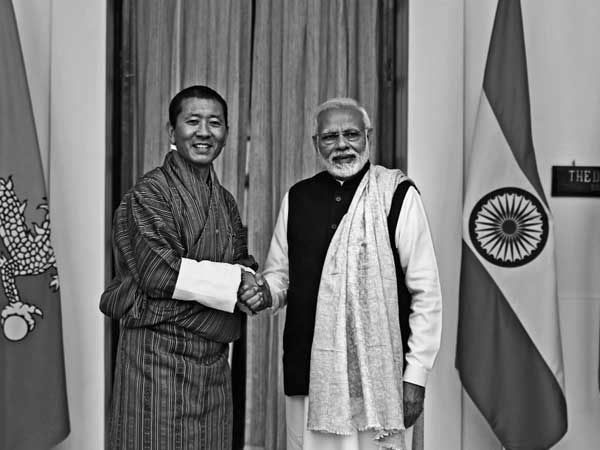
Bhutan’s newly elected Prime Minister Lotay Tshering’s first foreign visit as prime minister to India was an opportunity to review bilateral relations in the decade since Bhutan adopted parliamentary democracy. In these ten years as Bhutan moved from monarchial rule to elected government, it has experienced many changes, including growing political awareness and a generation of internet-savvy youth exposed to wider influences.
Bhutan is known globally for its gross domestic happiness philosophy, but efforts towards globalisation, democracy and modernization have brought with it the problems of unemployment, poverty and increased debt. The government has to relook its development process as inequality has increased with unemployment reaching 13 per cent for young Bhutanese.
Bhutan has chosen a new political party to head the government in each of the three general elections since the first elections in March 2008. The Druk Nyamrup Tshogpa (DNT) party led by Lotay Tshering was formed in 2013 and five years later went on to win 30 of the 47 seats in the National Assembly in October 2017. The new government has brought new plans for diversifying the economy to create more jobs and economic opportunities to make Bhutan more self-reliant.
During the Bhutanese leader’s visit, Prime Minister Narendra Modi reiterated that India would continue to play an important role in Bhutan’s development. Tshering said that he hoped to take India-Bhutan bilateral relations to even greater heights. Modi also announced that India would contribute Rs 4,500 crore as budgetary support for Bhutan’s new five-year plan. Though India’s contribution is the same as for the previous five-year-plan, it forms 15 per cent the plan’s total outlay compared to 23 per cent earlier. India fully funded Bhutan’s first five-year plan but the Indian contribution has steadily declined over the years.
A major objective for Bhutan from the India visit was to get a commitment on India’s development support and a satisfactory conclusion to the power tariff negotiations for the new Mangdechhu hydropower project. Discussions have been underway for several months at the official level. It took a political directive in New Delhi for a decision to be reached on what a joint press release called a “mutually beneficial understanding” for export of surplus power from the Mangdechhu project. The 720 MW project is to be commissioned shortly and the Tshering government hopes to use the additional export earnings to provide the funding for Bhutan’s new five-year plan. Bhutan also received an assurance of Indian support for the Sunkoshi project, which would be Bhutan’s first reservoir based hydropower project, and would produce electricity even during the winter months.
The Modi government has a ‘Neighbourhood First’ policy, but it still needs to be more generous in its approach and faster in its response to the needs of the neighbours. Delays in completion of hydropower projects by Indian companies have added to Bhutan’s increasing debt. Bhutan’s newer power projects have a different financing pattern with higher loan content, and Bhutan has been looking for a different tariff pattern for the new projects. Hydropower is Bhutan’s main export and revenue earner, but rising interest rates and different financing patterns have reduced the benefits of hydropower resulting in a higher Bhutanese debt.
However, the power ministry’s guidelines for cross-border transfer of electric power have been a sticking point with Bhutan for some time. The new regulations affected both Bhutan and Nepal as they allowed power export to India from wholly government owned projects or those projects that had a 51 per cent Indian ownership. The power ministry later revised its guidelines just before the Bhutanese PM’s visit.
Bhutan’s economic interests have been hit by Indian policies such as demonetisation and the Goods and Services Tax (GST). Both policies had an impact on neighbouring countries, like Bhutan and Nepal, whose economies are closely linked to the Indian market. GST procedures required a different set of documentation for import and did not recognize Bhutanese agricultural product certification. Farmers in Bhutan were unable to follow the procedures and Bhutan’s Rs 650 million cardamom exports to India dropped drastically. Farmers in Bhutan have suffered, and production has declined. The Bhutan government requested India to remove cardamom imports from the GST list but the cardamom issue has dragged on for over one and a half years.
The Doklam confrontation highlighted the China dimension in the relationship. New Delhi has been wary of Bhutan’s growing contact with China. Beijing is putting pressure on Bhutan to resolve the boundary issue on its terms. Chinese Vice Foreign Minister Kong Xuanyou visited Bhutan in July 2018 and had meetings with the Bhutanese leaders, including the King of Bhutan. The Chinese Minister also invited Bhutan to join Beijing’s Belt and Road Initiative. As Thimphu works out its ties with China, India needs to act as a genuine partner to Bhutan’s economic diversification and development plans.





